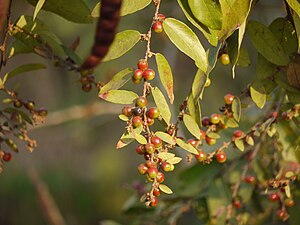Note: This is a project under development. The articles on this wiki are just being initiated and broadly incomplete. You can Help creating new pages.
Difference between revisions of "Bridelia stipularis - Ghonta"
(→External Links) |
|||
| (4 intermediate revisions by the same user not shown) | |||
| Line 1: | Line 1: | ||
| − | [[File:Bridelia stipularis ( | + | [[File:Bridelia stipularis (6780120560).jpg|thumb|right|''Ghonta'', ''Bridelia stipularis'']] |
| − | '''Ghonta''' | + | '''Ghonta''' is a straggling shrub that can climb up trees. Climbing Bridelia is a large, evergreen climbing shrub. Leaves are 5-20 cm, somewhat leathery, elliptic-obovate or orbicular-oblong. Flowers are small, in small axillary clusters or long spikes, often subtended by long stipular bracts. |
==Uses== | ==Uses== | ||
{{Uses|Inflammation}}, {{Uses|Ulcers}}, {{Uses|Wounds}}, {{Uses|Skin diseases}}, {{Uses|Asthma}} | {{Uses|Inflammation}}, {{Uses|Ulcers}}, {{Uses|Wounds}}, {{Uses|Skin diseases}}, {{Uses|Asthma}} | ||
| Line 11: | Line 11: | ||
==Common names== | ==Common names== | ||
| − | {{Common names|kn= | + | {{Common names|kn=Akshata balli, Bisila balli, Ashathe balli|ml=Kanjikottom, Cherukol panachi, Cheruman kottom|sa=Ghonta|te=Chiri aannem, Chiriannem, Dankibura, Dhantiboora, Donka-bhuvara|ma=Phatarpodi, Ran-phatarphad|en=Climbing Bridelia}}.<ref name="Common names"/> |
| − | <ref name="Common names"/> | ||
==Properties== | ==Properties== | ||
| Line 35: | Line 34: | ||
==Identification== | ==Identification== | ||
===Leaf=== | ===Leaf=== | ||
| − | {{Leaf|Simple| | + | {{Leaf|Simple|Alternate,4-8 x 2-6 cm|Leaves simple, alternate, 4-8 x 2-6 cm, elliptic-oblong, apex obtuse, base subcordate or rounded, minutely tomentose below, those of flowering branches much smaller; petiole c. 5 mm long }}<ref name="Leaf"/> |
===Flower=== | ===Flower=== | ||
| − | {{Flower|Axillary fascicles| | + | {{Flower|Axillary fascicles|Axillary spiciform racemes|Grenish yellow|5|Male flowers 2-3 mm across. Female flowers 4-5 mm across. Tepals 10, biseriate, ovate-acute, densely tomentose without, monadelphous.}} |
===Fruit=== | ===Fruit=== | ||
| − | {{Fruit|Drupe|5-6mm across| | + | {{Fruit|Drupe|5-6mm across|Globose, black, calyx persistent|Globose, black, calyx persistent|}} |
===Other features=== | ===Other features=== | ||
Latest revision as of 20:19, 26 August 2020
Ghonta is a straggling shrub that can climb up trees. Climbing Bridelia is a large, evergreen climbing shrub. Leaves are 5-20 cm, somewhat leathery, elliptic-obovate or orbicular-oblong. Flowers are small, in small axillary clusters or long spikes, often subtended by long stipular bracts.
Contents
- 1 Uses
- 2 Parts Used
- 3 Chemical Composition
- 4 Common names
- 5 Properties
- 6 Habit
- 7 Identification
- 8 List of Ayurvedic medicine in which the herb is used
- 9 Where to get the saplings
- 10 Mode of Propagation
- 11 How to plant/cultivate
- 12 Commonly seen growing in areas
- 13 Photo Gallery
- 14 References
- 15 External Links
Uses
Inflammation, Ulcers, Wounds, Skin diseases, Asthma [1]
Parts Used
Chemical Composition
Common names
| Language | Common name |
|---|---|
| Kannada | Akshata balli, Bisila balli, Ashathe balli |
| Hindi | NA |
| Malayalam | Kanjikottom, Cherukol panachi, Cheruman kottom |
| Tamil | NA |
| Telugu | Chiri aannem, Chiriannem, Dankibura, Dhantiboora, Donka-bhuvara |
| Marathi | NA |
| Gujarathi | NA |
| Punjabi | NA |
| Kashmiri | NA |
| Sanskrit | Ghonta |
| English | Climbing Bridelia |
.[2]
Properties
Reference: Dravya - Substance, Rasa - Taste, Guna - Qualities, Veerya - Potency, Vipaka - Post-digesion effect, Karma - Pharmacological activity, Prabhava - Therepeutics.
Dravya
Rasa
Tikta (Bitter)
Guna
Laghu (Light)
Veerya
Sheeta (cold)
Vipaka
Karma
Pitta
Prabhava
Habit
Identification
Leaf
| Kind | Shape | Feature |
|---|---|---|
| Simple | Alternate,4-8 x 2-6 cm | Leaves simple, alternate, 4-8 x 2-6 cm, elliptic-oblong, apex obtuse, base subcordate or rounded, minutely tomentose below, those of flowering branches much smaller; petiole c. 5 mm long |
Flower
| Type | Size | Color and composition | Stamen | More information |
|---|---|---|---|---|
| Axillary fascicles | Axillary spiciform racemes | Grenish yellow | 5 | Male flowers 2-3 mm across. Female flowers 4-5 mm across. Tepals 10, biseriate, ovate-acute, densely tomentose without, monadelphous. |
Fruit
| Type | Size | Mass | Appearance | Seeds | More information |
|---|---|---|---|---|---|
| Drupe | 5-6mm across | Globose, black, calyx persistent | Globose, black, calyx persistent | {{{6}}} |
Other features
List of Ayurvedic medicine in which the herb is used
Where to get the saplings
Mode of Propagation
How to plant/cultivate
Season to grow
Soil type
Propagation
Commonly seen growing in areas
Tropical area, Evergreen forest
Photo Gallery
References
External Links
- Ayurvedic Herbs known to be helpful to treat Inflammation
- Ayurvedic Herbs known to be helpful to treat Ulcers
- Ayurvedic Herbs known to be helpful to treat Wounds
- Ayurvedic Herbs known to be helpful to treat Skin diseases
- Ayurvedic Herbs known to be helpful to treat Asthma
- Herbs with Root used in medicine
- Herbs with Leaves used in medicine
- Herbs with common name in Kannada
- Herbs with common name in Malayalam
- Herbs with common name in Telugu
- Herbs with common name in Sanskrit
- Herbs with common name in English
- Habit - Scandent shrub
- Index of Plants which can be propagated by Seeds
- Index of Plants which can be propagated by Cuttings
- Herbs that are commonly seen in the region of Tropical area
- Herbs that are commonly seen in the region of Evergreen forest
- Herbs
- Plants of western ghats
- Climber
- Ayurvedic herbs that don't have seed photos
- Phyllanthaceae





